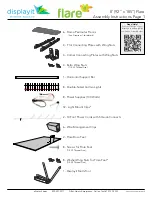
3-13
BIOS Setup
MS-98G6
▶
Console Redirection Settings
▶
Terminal Type
To operate the system’s console redirection, you need a terminal support-
ing ANSI terminal protocol and a RS-232 null modem cable connected be-
tween the host system and terminal(s). This setting specifies the type of
terminal device for console redirection.
▶
Bits per second, Data Bits, Parity, Stop Bits
This setting specifies the transfer rate (bits per second, data bits, parity,
stop bits) of Console Redirection.
▶
Flow Control
Flow control is the process of managing the rate of data transmission be-
tween two nodes. It’s the process of adjusting the flow of data from one
device to another to ensure that the receiving device can handle all of the
incoming data. This is particularly important where the sending device is ca-
pable of sending data much faster than the receiving device can receive it.
▶
VT-UTF8 Combo Key Support
This setting enables/disables the VT-UTF8 combination key support for
ANSI/VT100 terminals.
▶
Recorder Mode, Resolution 100x31
These settings enable/disable the recorder mode and the resolution
100x31.
▶
Legacy OS Redirection Resolution
This setting specifies the redirection resolution of legacy OS.
▶
Putty Keypad
PuTTY is a terminal emulator for Windows. This setting controls the numer-
ic keypad for use in PuTTY.
▶
Redirection After BIOS POST
This item specifies whether or not the console redirection is run after the
Power-On Self Test (POST).
[Always] Redirection is always active. (Some operating systems may not
work if this item is set to Always.)
[Boot Loader] Redirection is only active during POST.
[Disabled] Redirection is deactivated.










































